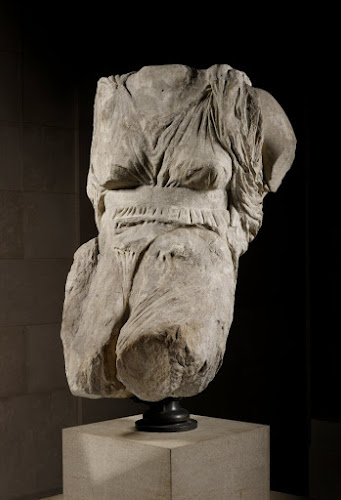 |
| Ancient Greek Culture Torso of Kouros 575-550 BC marble Cleveland Museum of Art, Ohio |
 |
| Ancient Greek Culture Torso of Kouros 520 BC marble Getty Museum, Los Angeles |
 |
| Ancient Greek Culture Torso of Kouros 520-510 BC marble British Museum |
 |
| Ancient Greek Culture Torso of Youth 500-450 BC bronze Metropolitan Museum of Art, New York |
 |
| Ancient Greek Culture Fragment of Male Figure 475 BC bronze Metropolitan Museum of Art, New York |
 |
| Ancient Greek Culture Torso of Kore 475 BC marble Getty Museum, Los Angeles |
"Meanwhile, Cycladic sculptors were looking to Egypt, receptive to foreigners from 664 [BC]. After ca. 650 the walking, kilted Egyptian males were adapted to form the kouros type, nude and free-standing – supposedly a discovery of Daedalus. Marble was the preferred medium, and adherence to the shape of the quarried block tended to make the finished work look like a four-sided relief. The type soon spread to east Greece and the mainland. In the earliest kouroi, as in their draped female counterparts, the korai, the Daedalic style predominated, but by ca. 600 [BC] its rigid stylization was breaking down as sculptors sought new ways of communicating male and female beauty, to delight the gods or to commemorate the dead."
"Only in Athens did a thorough-going naturalism evolve, as a by-product of a desire to understand the tectonics of the perfect human body in their entirety. By ca. 500 [BC] Athenian kouroi were fully developed human beings, their anatomy closely observed, clearly articulated, and skillfully integrated with the underlying physical and geometric structure of the body. Korai offered fewer opportunities for detailed physical observation, but just as many for displays of beauty appropriate to their subjects' station in life and value to a male-dominated world. Their sculptors concentrated on refining the facial features, creating a truly feminine proportional canon, and indicating the curves of the body beneath the drapery."
"By ca. 500 [BC] the drive to narrate convincingly had permeated virtually all sculptural genres, from gravestones to statue-bases. Hollow-cast bronze also began to replace marble, at least in free-standing sculpture. Its greater tensile strength now removed any technical restraint in the handling of narrative action poses. Only the kouroi and korai remained aloof – and look increasingly old-fashioned in consequence."
– Andrew F. Stewart, in The Oxford Classical Dictionary (3rd edition, 1996)
 |
| Ancient Greek Culture Torso of Youth 450-400 BC marble Metropolitan Museum of Art, New York |
 |
| Ancient Greek Culture Torso of Hermes (from the west pediment of the Parthenon) 445 BC marble British Museum |
 |
| Ancient Greek Culture Torso of Iris (from the west pediment of the Parthenon) 445 BC marble British Museum |
 |
| Ancient Greek Culture Torso of Amphitrite (from the west pediment of the Parthenon) 445 BC marble British Museum |
 |
| Ancient Greek Culture Torso of Aphrodite 3rd-2nd century BC marble Royal Collection, Great Britain |
 |
| Ancient Greek Culture Torso of Centaur 2nd-1st century BC marble Kunsthistorisches Museum, Vienna |
 |
| Ancient Greek Culture Colossal Torso 160-130 BC marble British Museum |
 |
| Ancient Greek Culture Fragment of Youth from Ionia 1st century BC marble Museo del Prado, Madrid |
 |
| Ancient Greek Culture Fragment of Kore 100-30 BC marble British Museum |